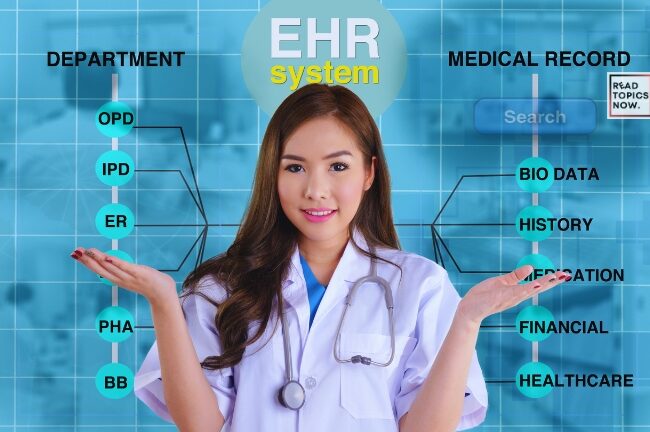
How Electronic Health Record (EHR) Integration is Transforming Healthcare

Understanding EHR
Before we dive in deep to explore how EHR integration software works its magic, let’s rewind a bit. Do you know what EHR and EHR integration are?
Electronic Health Records (EHRs) are the digital counterparts of traditional paper charts. They securely store a wealth of information about a patient’s health, including allergies, medications, diagnoses, and treatment plans. Think of them as a secure online vault for your medical history.
Can a patient’s medical history travel seamlessly with him? Eliminate the frantic search for your old records and redundant tests.
EHR integration is an invisible bridge connecting all compartmentalized medical information. Additionally, the patient’s medical history travels continuously with him within all the departments.
The lack of uniformity in EHR systems used across healthcare providers, clinics, and hospitals creates a major obstacle. EHR integration software is implemented to tackle this hurdle.
EHR integration breaks the barrier between all departments while allowing seamless data exchange between various EHR systems.
In short, EHR integration ensures medical information isn’t trapped in a data repository. They empower a more connected healthcare ecosystem, paving the way for better care for everyone.
Benefits of EHR Integrations
Let’s explore the key benefits of EHR integration.
1. Streamlined Data Exchange
Eliminate the frustration of lost faxes and misplaced records with EHR integration. Doctors now have access to a patient’s complete medical history, allergies, medications, diagnoses, and treatment plans in a few clicks.
Additionally, this translates to faster diagnoses, reduced time spent searching for information, and, ultimately, less time spent in waiting rooms.
2. Improved Efficiency and Patient Care
EHR integrations offer benefits far beyond streamlining workflows. With a holistic view of a patient’s health journey, doctors can make more informed decisions.
A more personalized approach toward care and treatment plans reduces the risk of errors.
Patient outcomes improve, and the healthcare system becomes more efficient.
3. Enhanced Data Security and Privacy
Since security and privacy are paramount in the digital age. EHR integration software actively prioritizes robust security measures.
People can achieve both robust protection of their sensitive medical information and authorized access and exchange of that data.
EHR integrations adhere to strict regulations to safeguard your data.
In essence, EHR integrations empower healthcare professionals with readily available information and improve patient care.
Challenges on the Road to Integrated EHR
EHR integration acts as a bridge between two islands that speak different languages. However, the core challenge of EHR integration is connecting disparate healthcare systems that might not communicate seamlessly.
Even though integrated EHR systems offer immense benefits, achieving a fully connected healthcare ecosystem requires overcoming some hurdles.
1. Interoperability Issues
Different EHR systems speak different languages. The absence of standardized data formats hinders seamless communication between EHR systems.
Interoperability problems occur when connected EHR systems can’t talk to each other because they use different formats or features.
EHR integration APIs, therefore, act as translators, facilitating smooth data exchange between different systems and ensuring everyone is on the same page.
2. Data Migration and Legacy Systems
Moving vast amounts of patient data from older, legacy systems into the new integrated EHR requires significant effort.
Incomplete or inconsistent data leads to errors and disrupts workflows. Integrating data during migration into the new EHR system requires data cleansing and careful planning.
Therefore, data sorting during migration ensures a smooth transition to the new integrated EHR system.
3. Cost of Implementation
The initial investment in the implementation of EHR integration software is significant. However, the long-term advantages outweigh the initial expenses.
By improving efficiency, reducing errors, and enhancing patient care, integrated EHR systems lead to significant cost savings in the long run.
It is an investment for the future. Despite the upfront cost, EHR integration offers substantial long-term benefits.
Address the issues of interoperability, data management, and implementation costs for a more connected and efficient healthcare future.
Key Considerations for Seamless EHR Integration
Building a strong foundation is important for a successful project, and the integration of EHR systems is also no exception. You don’t start building a house without a clear understanding of your needs and a blueprint.
Similarly, the road to a successful integrated EHR system starts with careful planning. Here are some key points to consider for a smooth and successful integrated EHR journey :
1. Defining Goals and Requirements
Define your goals. Identify the specific requirements that your integrated EHR software needs to meet.
Is it improved patient care, streamlined workflows, or better data analysis?
Therefore, considering these goals will guide your selection process. This selection ensures that the chosen EHR system perfectly aligns with the organization’s needs.
2. Assessing Existing Systems and Infrastructure
Understand the landscape before building a bridge. Assess your existing EHR systems and infrastructure, strengths, and weaknesses. Check its compatibility with potential integrated EHR solutions.
Evaluating your current system will help identify gaps that need addressing, ensuring a smooth transition to the integrated EHR system.
3. Selecting the Right EHR Vendor
Choosing the right partner is crucial for successful integration. Hire developers who have a proven track record in EHR integration and a strong understanding of your needs.
Developers that offer robust EHR integration APIs ensure seamless communication between your existing systems and the chosen integrated EHR.
Factors like scalability, security features, and ongoing support affect decision-making. Lay a solid foundation for your integrated EHR journey. Considering clear goals, infrastructure understanding, and selecting the right developers contribute to successful EHR software implementation.
Building the Bridge to Connected Care: A Step-by-Step Guide to EHR Integration
We’ve discussed the benefits and challenges of EHR integration above. Let’s see how this magic actually happens. How EHR integration actually works.
Bridge construction is a complex yet rewarding process with distinct stages, each crucial for a successful outcome. Let’s explore the EHR integration process through this step-by-step guide.
1. Develop a Project Plan
Every journey requires a roadmap. The first step involves crafting a detailed project plan outlining the specific need for EHR integration.
Thus, this plan encompasses timelines, budgets, resource allocation, and key stakeholders. It also defines communication strategies to keep everyone posted through the development process.
2. Design Data Architecture and Analyze Workflows
A patient’s data is the bricks and mortar of a bridge. Therefore, a robust data architecture must be designed. So that patient information can be exchanged between the existing systems and the integrated EHR.
Workflow analysis is critical. How will the new system handle existing workflows for tasks like appointments and medication management?
This analysis ensures a smooth transition and minimizes disruption for healthcare professionals.
3. Build and Test the Integration
Configure the EHR integration software and APIs to connect various systems. Rigorous testing is key for a smooth data flow and identifying any potential issues before deployment.
Here, EHR integration APIs act as invisible translators, facilitating seamless communication between your existing systems and the integrated EHR.
4. Train and Educate Users
Training and educating healthcare professionals on the new integrated EHR system ensures successful adoption.
This involves providing comprehensive training materials, workshops, and ongoing support to ensure everyone feels comfortable navigating the new system.
5. Roll Out and Monitor the System
In rollout, deploying the integrated EHR system in phases minimizes disruption to ongoing operations. Continuous monitoring is essential to identify any issues and ensure the system functions optimally.
By carefully managing each stage, healthcare organizations can achieve robust and efficient EHR integration, leading to a more connected and patient-centered future.
Technologies Enabling EHR Integration
We’ve explored the journey of EHR integration, but what tools pave the way for smooth data exchange and bridge the gap between different systems?
Here are some key technologies enabling seamless EHR integration:
1. APIs and Interoperability Platforms
Imagine a world where different languages have a universal translator. The EHR integration API (Application Programming Interfaces) acts as these translators.
They allow integrated EHR systems to communicate with existing systems by providing a standardized way to exchange data.
Interoperability platforms like Redox and Eligible enhance EHR integration by providing specialized tools and services.
These platforms act as the project managers, overseeing the communication between different systems through APIs.
2. Cloud-Based Solutions
Cloud computing offers a powerful advantage for EHR integration. By storing data on secure, web-based servers, cloud-based EHR systems eliminate the need for complex data transfers between physical locations.
This not only simplifies integration but also improves accessibility. Moreover, authorized healthcare professionals can access patient information from anywhere with an internet connection.
3. Mobile Integration and Telemedicine
The healthcare landscape is evolving. Mobile integration allows healthcare professionals to access and update patient data securely from their mobile devices. This fosters better care coordination and improves efficiency.
Furthermore, telemedicine integration allows for virtual consultations, seamlessly incorporating telehealth data into the integrated EHR.
These technologies are crucial for successful EHR integration.
Using the EHR integration API solutions, mobile integration, and healthcare organizations can create a more connected and efficient system, benefiting patients and providers.
Future Trends in EHR Integration
The world of EHR integration is constantly evolving, and the future holds exciting possibilities. Imagine a healthcare ecosystem where data flows freely and securely, empowering better care and groundbreaking discoveries.
Here are some emerging trends that will shape the future of integrated EHR systems:
1. Advances in Interoperability Standards
Think of a world where all languages share a common grammar. The future of EHR integration hinges on the development of robust and standardized interoperability standards.
These standards will ensure seamless communication between different EHR systems, eliminating the need for custom translations (APIs) and fostering a proper “plug-and-play” environment for integrated EHR.
2. Expansion of API Usage
Even with standardized languages, effective communication relies on skilled translators. EHR integration APIs will continue to play a crucial role in the future. As the healthcare landscape grows more complex, APIs will ensure smooth data exchange between diverse systems and integrated EHRs.
They will act as essential translators for various devices and applications.
3. Role of AI and Predictive Analytics
Artificial intelligence (AI) and predictive analytics will play a transformative role in future integrated EHR systems. By analyzing vast amounts of patient data, AI can identify potential health risks, recommend personalized treatment plans, and even predict outbreaks.
This data-driven approach will empower preventative care and improve overall patient outcomes.
4. Blockchain for Enhanced Security
Security is paramount in the digital age. Blockchain technology, known for its secure data storage capabilities, holds immense potential for EHR integration. By creating a tamper-proof record of patient data on a decentralized network, blockchain can significantly enhance data security and privacy within integrated EHR systems.
These trends promise a bright future for EHR integration. Standardized communication, advanced data analysis, and robust security will create a more connected healthcare system, allowing for personalized and preventative patient care.
Some Statistics Related to EHR
- Adoption Rate (US Physicians): Nearly 9 in 10 (88%) adopted an EHR by 2021.
- Reduced Medication Errors: Studies suggest a 48.8% error reduction with EHR use.
- Increased Patient Engagement: EHR use correlates with a 60% rise in patient engagement.
Final Thoughts
To conclude, an integrated EHR is the digital guardian of your medical records. Now, carry all your test reports, prescriptions, and medical records with you without any worries. No more frantic searches for old charts or duplicate tests.
EHR integration builds a bridge, to connect fragmented information and empower healthcare providers to deliver better care for everyone. The road to EHR is not smooth, but with careful planning, guidance, and the right technology, we can unlock the future of an efficient, patient-centered healthcare system.
The future of EHR integration is bright, and it’s designed to put you, the patient, at the center of it all. At last have a great diet to enhance your health.
Frequently Asked Questions
1. What is the difference between EMR and EHR?
EHRs (Electronic Health Records) are comprehensive digital records of a patient’s health information, while EMRs (Electronic Medical Records) are digital versions of paper charts in a single healthcare organization.
2. What are EHRs and their benefits?
EHRs are a big leap in digital healthcare, improving patient care by letting doctors access vital information quickly and speeding up diagnosis and treatment compared to paper records.
3. What is the process of EHR integration?
EMR integration involves connecting EMR systems with other healthcare software applications, facilitating seamless data sharing across different platforms. This process enables improved coordination and efficiency in healthcare delivery by ensuring relevant information is accessible across various systems.
Related Posts
Get Curated Post Updates!
Sign up for my newsletter to see new photos, tips, and blog posts.

SEO-savvy content writer and technical specialist with over 5 years of cross-industry experience. MBA graduate dedicated to crafting impactful narratives for your brand.






